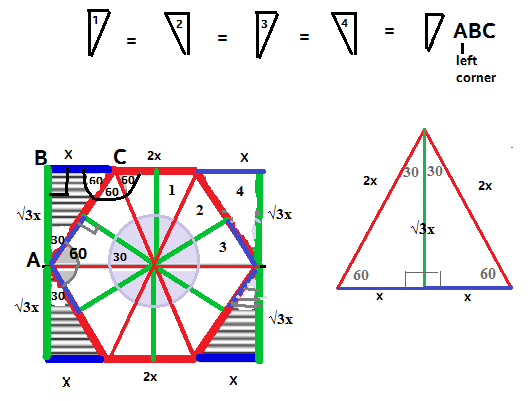Bunuel wrote:

In the rectangle above, if the unshaded region is equilateral and equiangular, what fractional part of the rectangular region is shaded?
(A) 1/6
(B) 2/9
(C) 1/4
(D) 1/3
(E) 4/9
Attachment:
The attachment 2017-09-26_1117.png is no longer available
Attachment:
 hexsquare.png [ 21.19 KiB | Viewed 6480 times ]
hexsquare.png [ 21.19 KiB | Viewed 6480 times ]
Explaining this solution is a lot harder than deriving it.
1. SIX EQUILATERAL TRIANGLES IN THE HEXAGON
This regular hexagon (equal angles, equal sides) can be divided into
6 equilateral triangles Diagram: each
equilateral triangle has side
2x2. EACH EQUILATERAL TRIANGLE DIVIDES INTO TWO CONGRUENT RIGHT TRIANGLES - see diagram, triangle on right
Equilateral triangles can be divided into 2 congruent right triangles
30-60-90 right triangles because:
--An equilateral triangle's median is also its angle bisector and perpendicular bisector
--One 60-degree vertex is bisected into a 30-degree angle in each right triangle
--The perpendicular bisector creates two 90-degree angles in each right triangle
-- Finally, the last vertex of the right triangle on both sides has measure of 60 degrees
SIDE RATIO OF 30-60-90 TRIANGLES
--30-60-90 triangles have sides in ratio \(x: x\sqrt{3}: 2x\)
3. HEXAGON HAS 12 CONGRUENT RIGHT TRIANGLES
There are 12 such identical triangles in the hexagon. SIX equilateral triangles * TWO right triangles each = 12 identical right triangles inside the hexagon
4. SHADED AREAS ARE IDENTICAL TO THE 12 RIGHT TRIANGLES INSIDE THE HEXAGON
The shaded areas (the corners of the rectangle) are congruent with all the right triangles inside the hexagon
Angles are congruent
--Each corner triangle is a 30-60-90 triangle - on diagram, see triangle ABC and the left side of the rectangle
-- 30- degree angle is on the straight line - see left side of rectangle
On that line, whose angles sum to 180, lies a 120-degree angle of a hexagon (or two 60-degree angles of the divided triangles)
180 - 60 - 60 = 60 degrees are left to be divided into two equal angles. On the line, each corner has a 30-degree angle
-- Each corner triangle has a 90-degree angle (by definition of rectangle)
-- Each corner triangle has a 60-degree angle - see left corner triangle, vertex C
Side lengths are equal
--Each corner triangle has exactly the same lengths as the 12 small triangles inside the hexagon: \(x, x\sqrt{3},\) and \(2x\) (see diagram)
5. FRACTION OF RECTANGLE SHADED?
12 triangles inside hexagon, 4 outside = 16 in rectangle. Four are shaded.
\(\frac{4}{16} = \frac{1}{4}\)
ANSWER C



 95%
(hard)
95%
(hard)
 62%
(02:27)
wrong
62%
(02:27)
wrong  based on 100
sessions
based on 100
sessions
